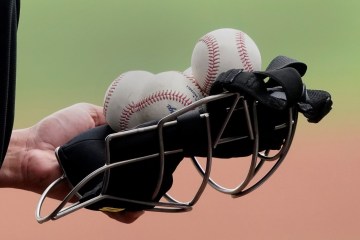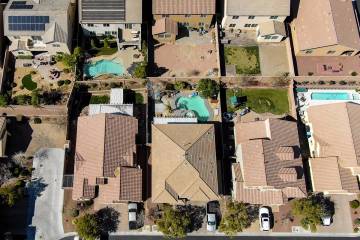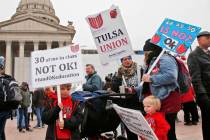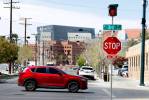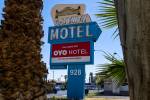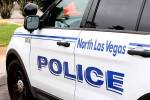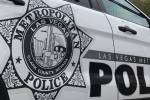Summerlin residents share memories of summer fun in Las Vegas
When Janice Haupt Allen arrived in Las Vegas, it was 1948. A reporter in Sebring, Ohio, for the Alliance Review, she’d come to take a job at the Evening Review Journal, now the Las Vegas Review-Journal.
Las Vegas had a population of about 10,000, she said.
“My first home was in Huntridge subdivision, owned by movie stars Irene Dunne and Claudette Colbert. … When we bought our first home for $12,500 in Huntridge, I was so excited to tell everyone at the paper. Some said, ‘Oh, did you get taken.’ Well, we didn’t. I lived in the house until 1970. Three bedrooms, two baths, beautiful backyard with a pool we had built in 1961.”
To combat the hot summers, she and her husband used swamp coolers.
“They worked good except if it got humid,” she said. “Windows had to be open for it to work. Think how unsafe that would be now.”
Cars did not have air conditioning then, nor were there refrigerator trucks. Still …
“Anderson Dairy delivered milk, butter, cottage cheese and eggs daily,” Allen said. “A little aluminum box sat by the kitchen door. Ice was put in by the milkman to keep everything cold in the summer months.”
Stores lined Fremont Street: J.C. Penney, Sears, Ronzone’s, Woolworths and Johnson’s. The Golden Nugget was “the” place.
To go to Mount Charleston meant carrying water in case the vehicle overheated.
Every couple of months, early in the morning, she said a plane flew over homes, dropping bug spray to kill mosquitoes and bugs.
“No one questioned it at the time,” Allen said. “Now, our windows were open for the swamp coolers to work, so we all breathed this poison while we slept.”
The Huntridge Theater was the place then to catch a movie. Children played in the desert that abutted Oakey Boulevard. There was no crime, she said, and people left their doors unlocked.
Hanging out with the Rat Pack
Jorge Guevara, 65, came to Las Vegas in about 1964 as a teen.
“It was when The Beatles came here. But I couldn’t go because I got grounded,” he said.
He used to ride his motorcycle, a Honda 90, in the desert near “the house where I live in Summerlin (near Rampart and Del Webb boulevards). I’d ride it right here.” Wildlife was abundant in what is now Summerlin, and he said he’d see rabbits, tortoises, scorpions, squirrels, snakes and roadrunners.
Guevara attended Las Vegas High School and the Southern Nevada Technical Center and was hired as a blackjack dealer at the El Cortez. He later was hired at the Stardust, where he worked his way up to casino manager.
“When the wind blew, they said on the news to make sure your car was in the garage because you’d wake up the next day, and the paint would be gone,” he said.
He hung around with the Rat Pack, hitting the golf links with Dean Martin — “We’d play at the D.I. He didn’t drink like everyone thinks,” Guevara said. “He was a gentleman, very laid-back.” — and socialized with Sammy Davis Jr. He met many movie stars — “the list is humongous,” he said — and knew Meyer Lansky, a mob man he said was a gentleman.
“The airport was really small. They’d land propeller planes right behind the Hacienda,” Guevara said.
Showgirls went to Mount Charleston for 3 a.m. breakfasts
Jean Webster Meneley came to Las Vegas in 1954. She was 17, had just come off a ballet tour of Europe and was hired to dance in a show at the Showboat.
“We were the pony line. Only the showgirls were tall, 5-foot-6 or more. That was considered tall back then,” she said. “I didn’t know there was a Strip. I thought downtown was the Strip.”
She later danced at other hotels, including the Thunderbird, the Sands, the Dunes and the Aladdin. In between shows, the girls were expected to “decorate” the lounge wearing cocktail dresses. One night, one of the high rollers approached, took her to the gaming tables and gave her $100 in starter money, which she turned into $2,500. He was betting $100 at a time and wound up with $40,000 for the night, prompting him to call her his good luck charm.
Another time, Frank Sinatra (whom she found to be arrogant) gave each of the dancers $100 to gamble. Meneley stuck it in her purse and went home instead. Dean Martin kept up his image as a suave drinker, she said, but really wasn’t one to drink at all.
She said the mob ran things smoothly, and Meneley recalled how well the dancers were treated. One show had them enter from the main doors and strut down the aisles in their costumes to take the stage. When a man started calling out rude comments, “One of the bouncers came over, grabbed the guy and tossed him out,” she said. “And this was a high roller. The mob didn’t put up with stuff like that. We girls felt protected.”
Sometimes, after a show, she and the other girls would head to Mount Charleston at 3 a.m. for breakfast. They’d also go horseback riding or picnicking there on their days off to escape the heat or go to Lake Mead to go water skiing.
Everywhere, it was obvious that the casinos were the backbone of the economy. “You’d go to the grocery store, and you could pay with casino chips,” she said.
She also recalled how Las Vegas had front-row seats for the test site experiments. After the first few ones, the atomic blasts were “not a big deal but still cool to see,” she said. “But we’d step outside and go, ‘Look at the sky and the gorgeous mushroom cloud.’ We just thought it was so beautiful. Little did we know.”
No one walked the Strip back then
Stacey Ranieri came to Las Vegas as a teen in 1972 from Washington state, where “you couldn’t see the forest for the trees, they were so thick.”
In Las Vegas, not only could one see the terrain, but “there was not one drop of rain.”
She recalled seeing Fremont Street for the first time. That was when cars were allowed on the street in both directions.
“I couldn’t believe how bright it was. It was like daytime, there were so many lights,” she said.
The town ended at Decatur Boulevard and northbound U.S. Highway 95 stopped at Valley View Boulevard. It took five minutes to get down Las Vegas Boulevard because there was so little traffic.
One of her first jobs was at the Bumble Berry Pie Parlor, which had “the best hot fudge sundaes.”
She lived on a doughnut from Winchell’s for breakfast and a kid’s size burger from McDonald’s for lunch. The latter cost 49 cents.
She bought her first car, a 1973 Honda Civic, paying $3,300 for it. Gas was 35 cents a gallon then.
The car had a black interior and no air conditioner.
“But it seems like it wasn’t as hot here then. I guess it’s global warming,” she said. “Yes, once in a while, you’d have days when it hit 100 degrees. If it got to 105, that was (notable). But now, 105 to 110 is normal.”
She said no one walked the Strip; the hotels were too far apart from one another.
“There was nothing but desert in between. You had to take a car,” Ranieri said.
Where Summerlin is now, she and her husband, Michel, would go hunting for rabbits.
Her sister was one of the first to buy a house in Spring Valley. But to get to it, one had to take a circuitous route, as Flamingo Road didn’t go all the way through.
“It was a long ways out there,” Ranieri said. “We thought she was crazy.”
To reach Summerlin Area View reporter Jan Hogan, email jhogan@viewnews.com or call 702-387-2949.






